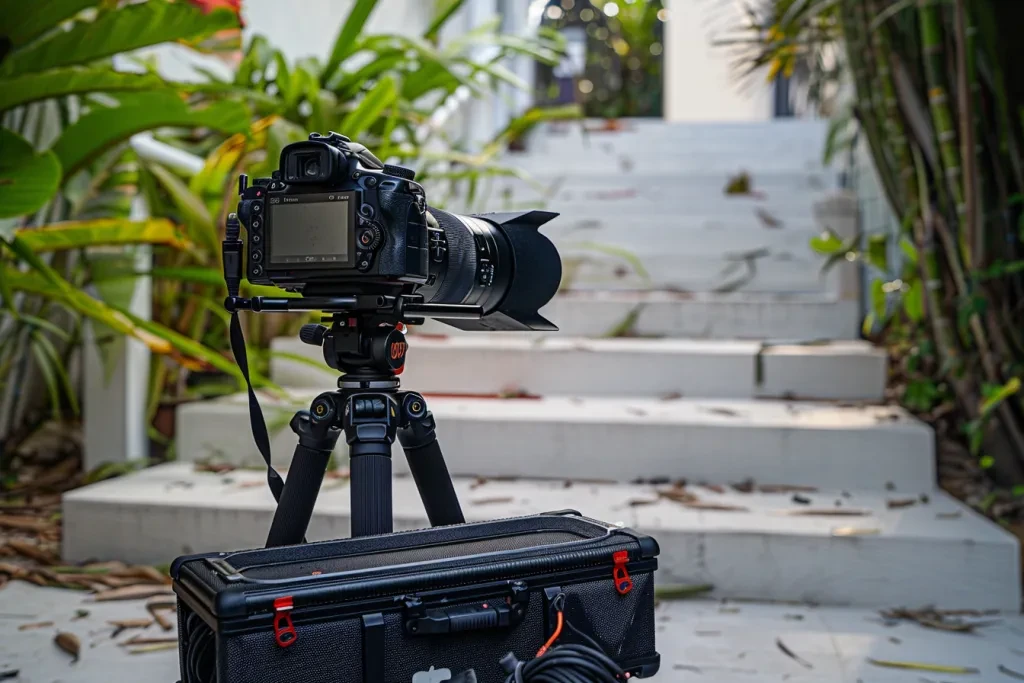As of 2024, the global 4K camera market is valued at approximately USD 20.65 billion and is projected to grow at a CAGR of 13.58% through 2029. This rapid expansion underscores the increasing demand for high-resolution imaging across various sectors, including entertainment, sports, and medical imaging.
Table of Contents:
– The Expanding 4K Camera Market: A Comprehensive Overview
– Key Factors When Selecting a 4K Camera
– Advanced Features to Look for in 4K Cameras
– Price Range and Budget Considerations
– Maintenance and Accessories
– Customer Support and Warranty
– Conclusion
The Expanding 4K Camera Market: A Comprehensive Overview

Market Overview: Current State and Projections
As of 2024, the global 4K camera market is experiencing robust growth, driven by increasing demand for high-resolution imaging across various sectors. Valued at approximately USD 20.65 billion in 2023, the market is projected to expand at a CAGR of 13.58% through 2029. This growth highlights the rising need for superior motion capture and analysis, particularly in entertainment, sports, and medical imaging industries.
North America and Asia-Pacific are the dominant regions in the 4K camera market. North America leads due to its advanced technological infrastructure and significant investments in research and development. Meanwhile, Asia-Pacific, with its growing middle class and rising disposable incomes, is rapidly adopting 4K cameras, especially in countries like China, Japan, and South Korea. The market’s expansion is further bolstered by the increasing popularity of streaming platforms demanding high-resolution content.
Key Performance and Market Dynamics
The 4K camera market is characterized by several key performance benchmarks and market dynamics. 4K cameras offer four times the resolution of traditional Full HD cameras, providing exceptional clarity and detail, crucial for film production, animation, and virtual reality experiences. The segment’s dominance is driven by the availability of affordable 4K cameras and growing consumer demand for high-quality content.
Advancements in sensor technology and image processing algorithms have significantly enhanced 4K camera performance. Companies like Sony, Canon, and Panasonic are continuously innovating to improve camera capabilities, such as real-time motion data visualization and analysis tools. These advancements increase the accuracy of motion capture and streamline workflows, allowing seamless integration of data from multiple sources.
Market share dynamics reveal that major players like Sony Corporation, Canon Inc., and Panasonic Corporation dominate the market. These companies invest heavily in R&D to maintain their competitive edge, focusing on developing advanced features such as improved tracking systems, wireless connectivity, and real-time analytics. This strategic emphasis on innovation ensures sustained growth and market leadership.
Innovations and Consumer Behavior Shifts
Recent innovations in the 4K camera market have transformed motion data capture, analysis, and utilization. Integrating technologies such as inertial measurement units, optical motion capture systems, and IoT sensors has propelled 4K camera capabilities. These advancements facilitate automated workflows, real-time analytics, and insights generation, enabling businesses to capture high-quality motion data, derive valuable insights, and expedite production cycles.
Consumer behavior is shifting towards a preference for high-resolution content, driven by the proliferation of 4K displays and streaming platforms. This shift is evident in the increasing demand for 4K cameras among professionals in filmmaking, sports broadcasting, and vlogging. The ability to capture crisp and detailed footage is crucial in these industries, driving 4K camera adoption.
Seasonal demand patterns indicate a spike in sales during major sporting events, film festivals, and holiday seasons when the need for high-quality content creation is at its peak. Additionally, the growing trend of social media content creation and sharing further fuels the demand for 4K cameras, as users seek to produce visually stunning and engaging content.
Regional Insights and Distribution Preferences
In 2023, North America dominated the 4K camera market and is expected to maintain its dominance during the forecast period. The region’s strong presence of major automotive manufacturers and aerospace companies actively incorporating advanced imaging technologies drives the market. The increasing focus on enhancing pilot situational awareness and reducing pilot workload has further fueled the adoption of 4K cameras in the aviation sector.
The Asia-Pacific region is showcasing the fastest growth, driven by technological advancements and increasing disposable incomes in countries like China, Japan, and South Korea. The region benefits from mass production capabilities and significant investments in research and development, which lower production costs and drive local demand. The presence of major action camera manufacturers and suppliers in countries like China and Japan gives the region a competitive advantage.
Distribution channel preferences reveal a growing inclination towards online sales, driven by the convenience and wide reach of e-commerce platforms. Major players are leveraging online channels to expand their market presence and cater to the diverse needs of consumers. Additionally, partnerships with local distributors and retailers in key regions help enhance market penetration and accessibility.
Key Factors When Selecting a 4K Camera

When choosing a 4K camera for professional or consumer use, several critical factors must be considered to ensure the best performance and value for the investment. Here are the primary considerations:
Image Quality and Sensor
The image quality of a 4K camera is largely determined by the sensor. A larger sensor typically provides better image quality, especially in low-light conditions. Full-frame sensors are often preferred for their ability to capture more light and detail compared to smaller APS-C or Micro Four Thirds sensors. Look for cameras with high-resolution sensors, advanced image processing, and features like back-illuminated (BSI) sensors to enhance light sensitivity.
Lens Compatibility and Options
The versatility of a 4K camera can be significantly enhanced by the range of compatible lenses. Interchangeable lens systems offer flexibility for various shooting scenarios, from wide-angle landscapes to telephoto wildlife shots. Consider cameras with a broad selection of native lenses and the ability to use third-party lenses through adapters. Lenses with high-quality optics, fast apertures, and features like optical image stabilization (OIS) can greatly impact overall image quality.
Video Recording Capabilities
4K cameras should offer robust video recording capabilities. Key specifications include frame rates (e.g., 24fps, 30fps, 60fps), bit depth (8-bit, 10-bit), and color sampling (4:2:0, 4:2:2). Cameras that support higher bit depths and better color sampling provide more flexibility in post-production. Look for cameras that can record in various codecs, such as H.264, H.265, and ProRes. Features like log profiles (e.g., V-Log, S-Log) and HDR recording can enhance dynamic range and color grading potential.
Build Quality and Durability
The build quality of a 4K camera is crucial for long-term reliability, especially for professional use. Cameras with a magnesium alloy body are typically more durable and can withstand harsh conditions. Weather sealing is important to protect the camera from dust and moisture. Check for robust physical controls, high-quality LCD screens, and electronic viewfinders (EVFs) that provide clear and accurate previews. Durability is often validated by industry certifications, such as IP ratings for dust and water resistance.
Connectivity and Workflow Integration
Modern 4K cameras should offer a range of connectivity options to streamline workflows. Essential features include HDMI output for external monitors or recorders, USB ports for data transfer, and Wi-Fi or Bluetooth for wireless control and file sharing. Some cameras also offer advanced connectivity options like SDI outputs and Ethernet ports for professional broadcast environments. Compatibility with external accessories such as gimbals, drones, and audio equipment can further enhance the camera’s versatility.
Advanced Features to Look for in 4K Cameras

Autofocus Performance
Autofocus (AF) performance is critical for both video and still photography. Advanced 4K cameras often feature sophisticated AF systems with many focus points, phase-detection or contrast-detection AF, and AI-driven subject tracking. For instance, Sony’s Real-time Eye AF and Canon’s Dual Pixel AF systems are known for their accuracy and speed. Reliable AF performance is particularly important for capturing fast-moving subjects and ensuring sharp focus in dynamic scenes.
In-Body Image Stabilization (IBIS)
In-Body Image Stabilization (IBIS) compensates for camera shake, allowing for smoother video and sharper images, especially in handheld shooting scenarios. IBIS systems use sensor-shift technology to counteract movement across multiple axes. This feature is invaluable for videographers shooting without a tripod and photographers working in low light conditions. Some cameras combine IBIS with lens-based stabilization for even greater stability.
High Dynamic Range (HDR) Support
HDR support enables 4K cameras to capture and reproduce a wider range of brightness levels, from deep shadows to bright highlights. This results in more realistic and visually appealing images. Cameras with HDR capabilities often support formats like HDR10, Hybrid Log-Gamma (HLG), and Dolby Vision. These cameras can record footage that maintains detail in both the darkest and brightest areas of the frame, making them ideal for high-contrast scenes.
Slow Motion and High Frame Rate Recording
Slow-motion capabilities are desirable for capturing dramatic and detailed footage. Look for 4K cameras that can record at high frame rates (e.g., 120fps, 240fps) in Full HD or 4K resolution. This allows for smooth slow-motion playback, which is useful for sports, wildlife, and creative video projects. High frame rate recording should be supported by robust internal processing to ensure high-quality output.
Advanced Audio Capabilities
Professional-grade audio is essential for high-quality video production. Consider 4K cameras with built-in high-quality microphones, as well as inputs for external microphones and XLR adapters. Features like manual audio control, headphone monitoring, and low-cut filters can significantly enhance audio recording quality. Some cameras also offer advanced audio processing features, such as noise reduction and audio level adjustment.
Price Range and Budget Considerations

Entry-Level 4K Cameras
Entry-level 4K cameras are ideal for beginners and enthusiasts. These cameras typically range from $500 to $1,200 and offer a good balance of features and affordability. Examples include models like the Panasonic Lumix G85 and Sony Alpha a6400. While they may lack some advanced features found in higher-end models, they provide excellent image quality and essential tools for basic video and photography needs.
Mid-Range 4K Cameras
Mid-range 4K cameras, priced between $1,200 and $3,000, offer more advanced features and better build quality. Models such as the Fujifilm X-T4 and Canon EOS R6 fall into this category. These cameras often include in-body image stabilization, more robust autofocus systems, and higher-quality sensors. They are suitable for serious enthusiasts and semi-professional users who require more flexibility and higher performance.
Professional 4K Cameras
Professional 4K cameras are designed for demanding users and can cost anywhere from $3,000 to $10,000 or more. These cameras, such as the Sony FX3 and Panasonic Lumix S1H, offer top-of-the-line features including full-frame sensors, advanced autofocus systems, and extensive connectivity options. They are built to withstand professional use and provide the highest image quality, making them ideal for filmmakers, professional photographers, and broadcast professionals.
Maintenance and Accessories

Regular Maintenance
Maintaining a 4K camera involves regular cleaning of the sensor, lenses, and body to ensure optimal performance. Use proper cleaning tools such as microfiber cloths, air blowers, and sensor swabs. Regular firmware updates are also crucial to keep the camera’s software up to date with the latest features and bug fixes. Storing the camera in a dry, dust-free environment can prevent damage and prolong its lifespan.
Essential Accessories
Several accessories can enhance the functionality of a 4K camera. Essential items include high-capacity memory cards, spare batteries, and a sturdy tripod. For videographers, external microphones and portable LED lights are invaluable for improving audio and lighting quality. Gimbals and stabilizers can provide smoother footage, while ND filters are useful for controlling exposure in bright conditions. Additionally, protective cases and camera bags are important for transporting and safeguarding the equipment.
Upgrade Potential
When investing in a 4K camera, consider its upgrade potential. Cameras with modular designs and extensive accessory ecosystems allow users to expand and enhance their setup over time. Compatibility with future firmware updates and new accessories ensures that the camera remains relevant and functional as technology evolves. This upgrade potential can significantly extend the camera’s usability and value.
Customer Support and Warranty
-1.jpg?x-oss-process=style%2Ffull)
Manufacturer Support
Reliable customer support is essential for resolving any issues that may arise with a 4K camera. Look for manufacturers with a strong reputation for customer service and support. Access to online resources, user manuals, and community forums can also be helpful. Some companies offer dedicated support lines and service centers for professional users.
Warranty and Return Policy
A comprehensive warranty provides peace of mind when investing in a 4K camera. Check the warranty terms to understand what is covered, including parts, labor, and potential exclusions. A good return policy is also important, allowing users to return or exchange the camera if it does not meet their expectations. Extended warranty options can provide additional coverage beyond the standard warranty period.
Resale Value
High-quality 4K cameras from reputable brands tend to retain their value well. Consider the camera’s potential resale value when making a purchase. Cameras that are well-maintained and come with original accessories and packaging can often be sold for a good price, allowing users to upgrade to newer models in the future without significant financial loss.
Conclusion
When choosing a 4K camera, it is essential to consider factors such as image quality, lens compatibility, video recording capabilities, build quality, and connectivity options. Advanced features like autofocus performance, in-body image stabilization, HDR support, slow-motion recording, and audio capabilities can further enhance the camera’s functionality. Budget considerations, maintenance requirements, and available accessories also play a crucial role in making an informed decision. Finally, reliable customer support, warranty, and potential resale value are important aspects to ensure a satisfactory and long-lasting investment in a 4K camera.




